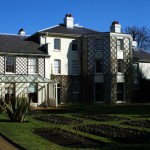Down House: Charles Darwin’s Former Home
Our English Heritage membership came up for renewal this month and what better way to celebrate than to take our first trip of the year to Down House, home of British scientist Charles Darwin.

Down House is a little south of the village of Downe (the spelling of the village seems to have acquired its ‘e’ ending about the turn of the 19th century when still a Kent parish) and can be accessed by country lanes leading from the A21 or A233. It is a little off the beaten track and for us on this chilly February morning, the brown heritage signs on the roadsides provided better navigation aids than our Yahoo! driving directions.
The self-guided tour (using provided audio-visual devices and headsets) is divided in to two sections: the interior and the grounds.
The grounds include the gardens, a greenhouse, the barn (where usually there are active colonies of bees which, sadly – for us, not them – had been shipped out to warmer climes for the winter) and the remains of the tennis court. Extending beyond the gardens is a trail of about a mile known as the Sandwalk. Apparently, Darwin would walk this trail daily when taking a break from his work. Some nice views of the south-facing rear of the house can be had from the Sandwalk.
Inside the house is where this location comes in to its own. Much of the downstairs interior has been expertly restored to appear as it did during Darwin’s life (after Darwin’s death, the house was a private girls’ school, and later was given to the Royal College of Surgeons as a research facility before it was bought and restored by English Heritage in 1996.) Darwin lived at Down for 40 years, and wrote the full text of On the Origin of Species in its study.
With many original pieces of furniture and other items loaned from Darwin’s family or from private collections, the restorers have commendably created the look and feel of a lived-in Victorian house. From the decorative grand piano, slate billiard table, full Wedgwood dinner service (Darwin’s wife, Emma, was grand-daughter of Josiah Wedgwood the renowned potter; Darwin inherited the service from his mother, another of Josiah Wedgwood’s prolific progeny – the Darwin/Wedgwood tree is a little complicated, as you’ll see) down to pens and ink blotters, parlour games and distractions, maps and period magazines, it is all there offering a very vibrant feel of what it may have been like to live alongside the Darwins.
The upstairs is structured like a museum, with several rooms exhibiting artifacts, a games room where vital aspects of Darwin’s theories are described in games, videos and puzzles, and a room to rest in where children can dress up in period clothing.
This was a great half-day trip and we hope to return again in the summer to see the gardens in bloom.
